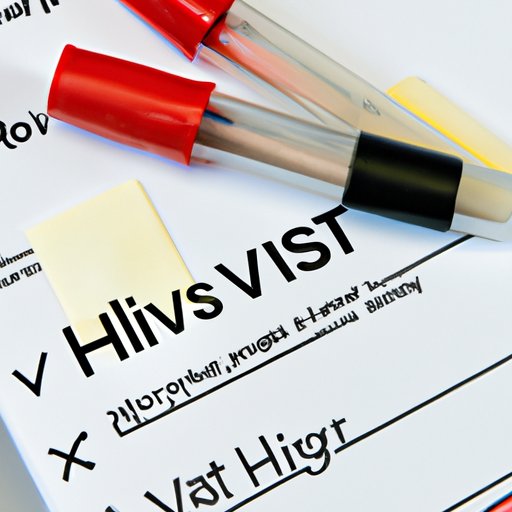
Introduction
HIV (Human Immunodeficiency Virus), a virus that attacks the immune system, is a significant global health concern. While the virus can be managed with proper treatment, living with HIV without knowing can have devastating consequences on an individual’s health and longevity. The purpose of this article is to educate readers about the risks of contracting and living with HIV without knowing, while also addressing the stigma surrounding HIV testing and providing hope for living a long and healthy life with the virus.
The Silent Danger: Living with HIV without Symptom
One of the greatest dangers of HIV is that it can be contracted without knowing. People living with HIV can initially show no symptoms, which makes contracting the virus even more dangerous. The virus is commonly transmitted through unprotected sex, sharing needles, and mother-to-child transmission during childbirth or breastfeeding.
HIV can go undetected in an individual’s blood until they go through the window period, which is the time between exposure to the virus and when a test can detect the virus. The window period can last between 2 to 12 weeks, depending on the individual’s immune system. During the window period, an individual can still transmit the virus to others. After the window period, an individual can start to experience common symptoms like fever, fatigue, dry cough, and night sweats.
To stop the spread of HIV, it’s crucial to get tested regularly. Testing and early detection can prevent the virus from progressing and increasing the risk of spreading it to others.
The Risk: Delayed Detection of HIV
Delayed detection of HIV can have significant health consequences that may affect an individual’s lifespan. Untreated HIV can lead to AIDS (Acquired Immunodeficiency Syndrome), which is a severe illness that compromises the immune system. HIV can also increase the risk of other serious health issues like tuberculosis, pneumonia, and different types of cancer.
Early detection of HIV can help an individual live a long, healthy life. It enables them to start receiving treatment and care, which reduces the risk of progressing into AIDS and other severe health complications. According to the Centers for Disease Control and Prevention (CDC), early detection and treatment of HIV can reduce the risk of transmission by 97 percent.

The Stigma: Overcoming Fear of HIV Testing
The stigma surrounding HIV can deter individuals from getting tested and knowing their status. Unfortunately, the fear of testing positive often outweighs the potential benefit of early detection and treatment. Lack of education and experience of HIV can also create misconceptions and stereotypes that lead to stigma.
Educating communities on what HIV is and how it can be contracted is a crucial part of overcoming the stigma around HIV testing. Encouraging people to get tested and providing support and resources after a positive diagnosis can help in breaking down the stigma and empowering individuals.
There are many resources available for finding HIV testing and support, such as community health clinics or HIV/AIDS organizations. These resources provide confidential testing, counseling, and care services to individuals with HIV.
The Hope: Living Long and Healthy with HIV
Living with HIV is no longer a death sentence. With proper care and support, people living with HIV can have a long and healthy life. Medical advancements in HIV care have improved quality of life and even allow for undetectable viral loads, which means that the virus can no longer be transmitted to others.
Antiretroviral therapy (ART) is a treatment regimen that includes a combination of medications taken daily to suppress the virus and prevent it from progressing. ART can also reduce the risk of transmission, allowing people living with HIV to achieve and maintain undetectable viral loads.
Pre-exposure prophylaxis (PrEP) is a medication for people who are HIV-negative but at high risk of contracting the virus. PrEP can reduce the risk of contracting HIV by up to 99 percent when taken daily as prescribed.
There are many examples of individuals who are living well with HIV and the support they receive. They emphasize the importance of finding the right healthcare provider and seeking out resources for care and support. Having access to medicine and emotional support allows people living with HIV to live a full and healthy life.
The Education: Knowing Your Status Matters
Knowing your HIV status is crucial to prevent the transmission of the virus. Experts recommend regular testing for individuals who have had unprotected sex with a partner or partners whose HIV status is not known. It’s also important to get tested if you’ve shared needles or have concerns about potential exposure to HIV.
Resources like the National HIV and STD Testing Resources website provide guidance on how often individuals should be tested based on their risk factors. Talking to a healthcare provider about testing can help individuals determine what testing frequency is appropriate for them.
There are also many resources for finding HIV testing locations and advice for talking to a healthcare provider, including HIV/AIDS organizations like The Body and the Black AIDS Institute.
The Prevention: Testing, Treatment & Prevention
Getting tested, diagnosed, and treated for HIV can prevent the further spread of the virus. The sooner an individual is diagnosed and receives treatment, the lower the chance of transmission to others.
While ART can make an individual’s viral load undetectable, it’s important to note that they can still transmit the virus if they stop taking their medication. It’s also crucial to use condoms or other forms of protection during sex to prevent the spread of HIV and other sexually transmitted infections.
Prevention methods like PrEP should also be considered by individuals who have tested negative but are at high risk of contracting HIV. PrEP is a highly effective medication that can reduce the risk of contracting the virus when taken daily as prescribed.
Community-level awareness is crucial in preventing the spread of HIV. Getting tested regularly and being educated on safe sex practices and prevention methods can help prevent new cases of HIV.
The Future: Early Detection and Innovative Treatments
Scientific researchers are continually working to find new treatments for HIV and, ultimately, a cure. The future of HIV research is promising and offers hope for individuals living with HIV. New treatments could reduce or eliminate the need for daily medication and improve overall health and longevity.
The development and implementation of at-home HIV testing could also provide a more accessible and convenient way for individuals to know their status. Early detection adds to the success of HIV treatment and provides opportunities for more healthy outcomes for individuals living with HIV.
Conclusion
Living with HIV without knowing can have devastating consequences on an individual’s health and longevity. That’s why it’s essential to engage in regular testing and early detection of the virus. Overcoming the stigma around HIV testing and seeking support is also vital in living a healthy and fulfilling life with HIV. Medical advancements and treatments like ART and PrEP allow for undetectable viral loads and prevention of transmission, offering hope for individuals living with HIV. Early detection and innovative treatments provide hope for a healthier future, but it all starts with getting tested and seeking treatment.




